



As the people of the Kurdistan Region prepare to head to the polls on September 25, 2017, in a historical referendum on Kurdistan's independence, we compare the economies of Iraq with other nations and ask, “What economic structure would a sovereign Kurdistan take?"
Read MoreThis is not a political opinion, but an economic point of view. Some people in the Kurdistan Region oppose the proposed referendum for independence just because it's adopted by a certain party, while others argue that this isn't the right time for a serious step like that as the Region is suffering from severe economic crisis.
Read MoreKaufmann et al (1999) defined "governance as the traditions and institutions that determine how authority is exercised in a country." Based on available literature including thoughts of neo-institutional scholars including, Douglass North and MancurOlsan, a positive relationship between the quality of institutions, governance structures, and economic growth is found.
Read MoreAgriculture and Water Resources in Kurdistan Region – Iraq
Past, Current reality and Future prospects
Prepared by: Dr. Anwar Omer Qader, D.G. of Planning and Follow up
A brief History
Kurdistan was the first nest and the birthplace of humanity and civilization, where the earliest people departed to from the mountains and wildlife. The village (Charmo) in Chamchamal district– Kurdistan Region is the tangible and live evidence of this fact, and it is considered as the first Agricultural village in the world and the most ancient agricultural habitation in new Stone Age, during (1948-1955) the professor (Brid Wood) from the east institute of SAM languages and Arts that belongs to Chicago University – USA, who did the prospecting in the village and he found around (25-30) mad houses and stone home basis. With the remnants of the bones of animals, goats, pig, deer, and the dog, this was domesticated by the villagers. And also it has been found grains of wheat and barley in those houses and especially in the graves.
The history of the village returns to about 10,000 years BC, and the information confirming that the people of the area were of Kurdish nationalism and working on agriculture and the history of agricultural revolution started from this village and transported to other places. And that this region was the owners of wheat, barley, chickpeas and lentils, and domestic animals such as goats, deer and pig and dog before other nationalities.
But after the second half of the previous century many destruction campaigns has made in the area that led to the demolition of (4,500) villages of the total of (5,131) villages, and displaced villagers to compulsory compounds (Residential areas) and confiscation of their lands, burning of forests and orchards and switch careers peasants from Farmers to a service workers. And those reasons and many others led to the collapse of the agricultural situation and the decline of self-sufficiency to importing region.
To renovate previous abilities and characteristics it had to put the idea of the strategic plan in 2006 to during the fifth cabin of the Region Government and it has been implementing the five-year plan in 2009 with participation of other sectors such as water resources, trade and food industries. But because of a lack of budget which provided only (9.2%) of the required budget, so it could not implement all goals but we got some joyful results of some products such as wheat and potatoes that can cover more than 100% of region needs and for some other products can cover 54% and some other was below of our requests that does not reach 40%, but conclusion average plan decreased the total local products around 15% and covered 30%-45% local consumption. And from this point of view the ministry of agriculture and water resources of Kurdistan Region suggested the future plan for other five years (2015-2019) but for the reason of financial crisis and ISIS was and the cutoff of regions’ share of the Iraqi budget (17%) by GOI led to the non-implementation of the plan. Actually the financial crisis affected the agricultural sector especially in the farmers’ subsidy from one hand. From the other hand the ministry of agriculture and water resources took this opportunity to take advantage because most people lost their source of income and this gap offset by agricultural activities some people went to agriculture and villages for work and the Agricultural activity and agricultural employment increased from 16% to 20% and also led to increase the products.
The current reality
of the agriculture sector and water resources
The geography of Kurdistan region is very suitable for the practicing the agricultural activities in both plant and animal because it has a wide plain area as well as mountain area the measure of the plain area is around (924,000 Ha.) and it is considered as the best soil for planting and also Regions’ climate is suitable for multiple agricultural products, high temperature in some areas, medium temperature in other places and low temperature in other places, and also 50% guaranteed rain-fed area, 35% semi-guaranteed and 15% non-guaranteed, so can the Region plant some products that depend of rain in different times, The current reality of the agriculture is shown as below:
1- Kurdistan Region Map:

2- The KRI’s land size in hectares:

3- No. of villages in Kurdistan Region

4- Water Resources status
A- Surface Water in the Kurdistan Region

B- Completed Dams

C- Completed Ponds

The total reservoirs capacity is 10,098.325 million m3
D- Dams under construction

E- Ponds under construction

F- The status of irrigation projects
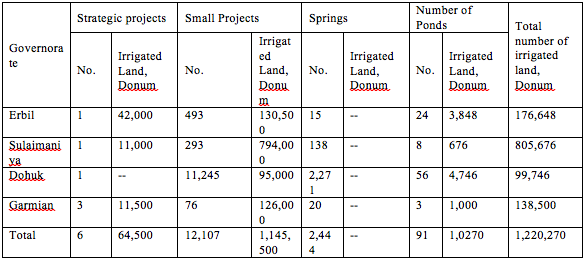
G- Deep Wells

5- Animal wealth status
A- Poultry projects

B- Number of Animals
1- Number of Sheep, Goats, Cows and Buffalo
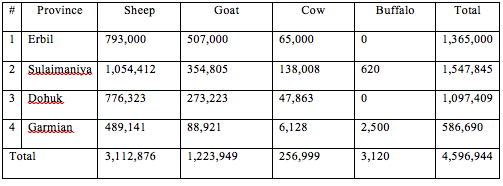
2- Meat animal projects
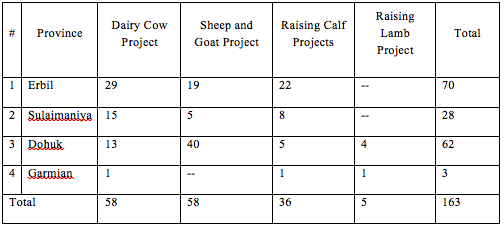
3- Fish projects
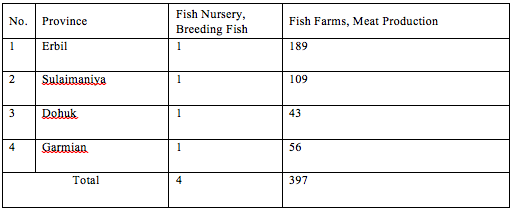
6- Animal Production Level in KRI, 2015

7- Plant production status
A- Green houses projects in Kurdistan Region (Private Sector):

B-Cultivated Lands/Lands under Cultivation
1. Field Crops, grains and beans

2. Vegetables

3. Forrest and Rangelands

C – Level of plant production in 2015
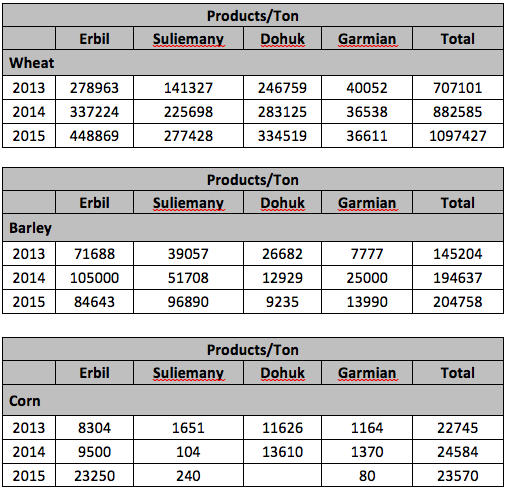

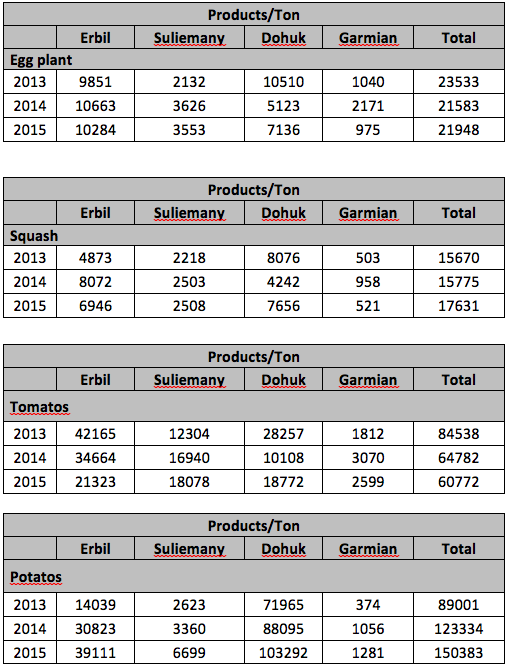
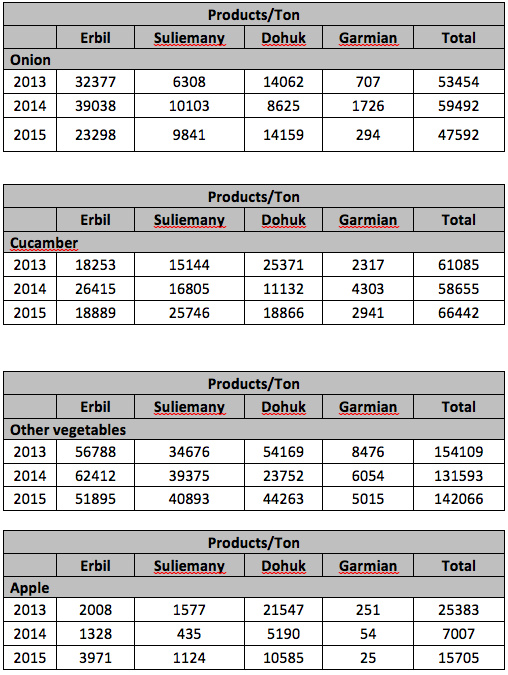

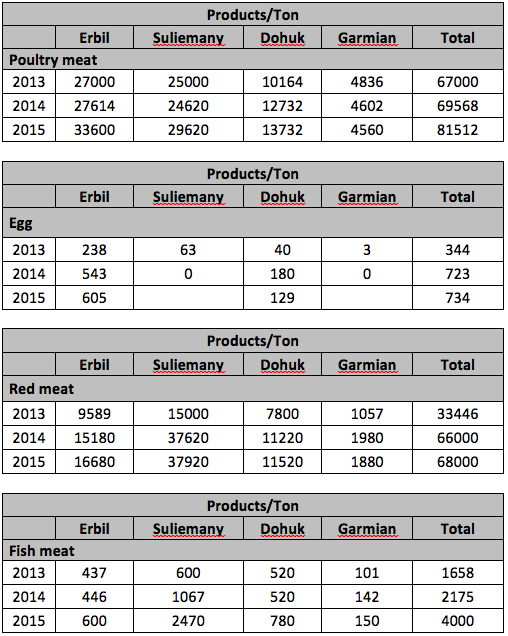

8- Investment projects
A. Invest. Under ministry's law (2007-3015)

B. Invest. Under Investment law (2007-2015)

Ministries' Plan for agriculture and water resources sectors
1. Brief on the Agriculture and Water Sector Roadmap, 2015-2019
The vision of the Ministry of Agriculture and Water Resources (MoAWR) is the following: “Obtaining food and water security in the KRI.” The mission of the MoAWR for the next phase is food and water sufficiency for the KRI, which comprises the main goal of the roadmap. All the projects and objectives are designed to serve this goal according to the available human and financial resources for each objective.
The duration is five years, starting from 2015 and ending in 2019. It is projected that with a 3% annual population growth rate, the population of the KRI will increase from 5,356,531 to 6,209,688 by 2019. The projected food and water needs are based on the estimated population of the KRI in 2019 and take into consideration the calories a human body needs on a daily basis, which is 2,800 to 3,200 calories.
The food and water reserves in 2014 serve as the baseline for these projections; in addition, we conducted analysis to the agriculture and water reality in KRI, and the risks that these two sectors might face.
The roadmap includes eight objectives. Each includes several strategic goals, and each goal consists of several plans, projects, programs, and mechanisms. The policy for the next phase of the Agriculture and Water Sector has been outlined in the roadmap, due to their key role in achieving the goals and missions of the MoAWR’ agencies. These goals include proper rules and regulations, accompanied by inspiration and guidance from the MoAWR. The institutional functioning, the organizational structure and courses of action start from the top of the pyramid, starting with the MoAWR and devolving down toward the bottom agencies. In the base line, it starts with the farmers and continues to the production units in the fields and villages. Farms shall become scientific workshops and on-job training sites for the farmers.
The proposed budget for the roadmap is 3,030,200,000,000 dinars. The duration of the plan is five years. The indicators are the following: increasing local production by 20%, increasing the water storage capacity by 3.9%, increasing the irrigated lands by 4.1%, increasing green spaces by 0.5%, decreasing diseases and infectious diseases by 80% and 30% respectively, applying modern marketing systems, decreasing the trespassing of agricultural lands by 80%, and increasing agricultural investment by 3%.
To insure the success of the plan, teams for the follow-up and evaluation of staff performance and projects shall be formed on the KRI’s level as well as within each province.
2- The vision of Agriculture and water sector in the KRI:
(Ensuring food and water security in the Kurdistan Region of Iraq)
3- The mission of Agriculture and water sector in the KRI, 2015-2019
(Self-sufficiency of basic foods and water in the KRI)
4- Kurdish Population growth
From(5,356,531) in 2015 to (6,209,688) in 2019. Increase rate 3%.
5- Individual basic needs from food and water
A. Per Capita requirements of food and water: for food self-sufficiency, the basic needs from food for obtaining the needed calories by a normal person under international standards are shown in the following table, along with the needs of the total residents for one year.
Table 1: Individual needs from foods

B. Water demands of individuals and sectors: The following table shows thedemand for water from individuals and sectors along with the amount of water needed for livestock.
Table 2: Individual and sectors demand from water
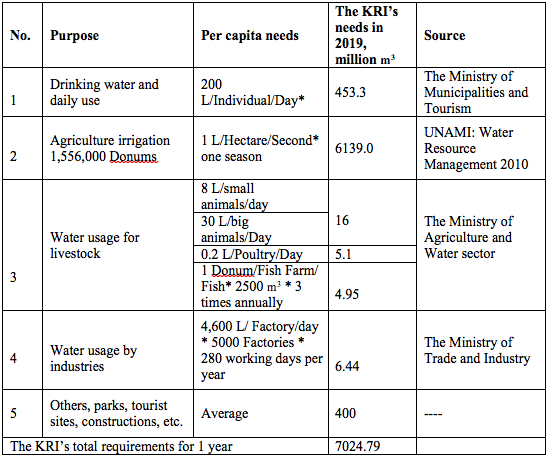
6- Analysis of the Agriculture and Water Sector’s Reality in the KRI
A- Agricultural Products:
As the climate differs in the Kurdistan region from one place to another, the MoAWR is currently working on a new structure for determining the right location for the right crop according to the type of land, precipitation, and temperature. Only by considering these variables, we can be on the right path to raise the current level of strategic products. Currently, all of these depend on the farmer’s judgment and expertise, as well as the limited experiments of agricultural study centers. Eventually, the level of production is not up to the ambitions of the MoAWR.
B- Field Crops:
It is delightful that wheat—which is a basic and strategic foodstuff for residents—can meet the KRI’s demand. This is due to the support from the MoAWR, which resulted in raising the production to 844,582 tons in 2014, more than one million tons in 2015 and 1,686,000 tons in 2016.
The support consisted of establishing four plants for wheat seed cleaning, which can provide 15,000-20,000 tons of cleaned and processed wheat seed to the farmers with a subsided price. Furthermore, providing farmers with high quantities and qualities of irrigation sprinklers have played a key role especially in Erbil province. A sprinkler is used to irrigate 24,000 Donum of cultivated land with wheat. Purchasing the wheat product by the public silos was another factor in raising the production.
This experience can be introduced to other crops, thus supporting the production needs rather than planting needs.
Corn production also witnessed the right steps; in 2009 the annual production was only 500 tons, but currently the annual production has hit 23,578 tons. These increases can be attributed to the MoAWR support in providing seeds to the farmers.
The main problem that faces the farmers is marketing the corn. The MoAWR must find a solution to this, such as purchasing the farmers’ produce and distributing them on meat animal resources’ projects.
As for barley, lentils, and sunflower seeds, which haven’t received sufficient support, the production hasn’t achieved its goal. For the next phase, these crops should be given the same support as wheat in order to cover the KRI’s demands.
C- Vegetables and Fruits
Potato production has achieved self-sufficiency, similar to wheat, due to the right amount of support from the MoAWR. Providing the best true potato seeds accompanied by providing ongoing instructions to the farmers and protecting the product during the marketing phase are considered to be the other main factors that have helped in achieving self-sufficiency. Production is 123,334 tons in 2014 and 150,383 in 2015 while the KRI’s demand for this product is 77,000 tons.
Other vegetables can cover 62% of local demand. The basic requirements for self-sufficiency from vegetables do exist in the KRI, provided that each strategic product (e.g. tomato, onion, and cucumber) is raised under a separate project and a special committee and department is established for each of these products.
The fruit production is low; it can provide 32% of local demand. Each product ripens at a specific time and exceeds the market’s demands. Many times the farmers lose rather than benefit. Therefore, focusing on the four strategic products (pomegranate, grape, apple, and peach) via supporting the farmers and finding markets for the products remains a priority for the MoAWR during the next phase. Just like potato and wheat, fruits require their own project as well.
Developing the cultivation of olive is also important for producing vegetable oil. This was included in the previous plan, which supported the farmers in the development of olive gardens of 5-10 Donums per each farmer, reaching 5,500 Donums in total. The private sector also developed 15,000 Donums. This makes a grand total of 20,500 Donums. This field is still very small and scientific studies should be carried out to the next phase in order to find actions for attracting investors, which could be fulfilled via allocating lands for this product and providing facilitation for the investors. In parallel to this program, the MoAWR should help establishing olive oil mill plants through supporting the private sector. Additional to these facts in 2015 MoAWR signed cooperation agreement with Italian country to develop olive sector in Kurdistan region on the cooperation budget which granted from Italy to MoAWR and the project includes technical assistance, training, establishing association for farmers in olive sector and installing mill for them.
Vegetable and fruit production as a whole have declined, particularly in 2014, when compared to previous years. This is due to the decrease in temperature that spread through the region between 31/3/2014 and 1/4/2014.
D- Meat Animal production
Meat animal production includes poultry, livestock/cattle, and fish. Poultry have a solid infrastructure, for both meat and egg production; however, due to strong competition from imports, the local products cannot prevail. Furthermore, the support provided by the MoAWR was not sufficient, especially in regards to providing fodder, medicine, and vaccines, which eventually affected production. The annual production of chicken meat was only 69,568 tons in 2014 but in 2015 was 81512 tons, which covers 63% of local demand. The production of eggs was 723 Million Eggs in 2014 and 734 Million in 2015, which covers 95% of local demands.
However, we can achieve self-sufficiency for chicken meat and eggs with the current infrastructure if the imports are controlled, with sufficient support directed at production rather than needs, and if the production is directed through supporting the marketing process and protecting domestic products against imported products.
The number of cattle, sheep, goats, cows and buffalo has reached 4,596,944. This number is fluctuating due to several issues that haven’t been tackled, such as lack of interest in animal husbandry by farmers and the appointment of farmers as civil servants, which has led to the marginalization of the agriculture sector, especially animal husbandry, by villagers and farmers.
Furthermore, drought seasons have had a negative impact on water resources; both drinking water for animals and rangelands were affected. Moreover, the cattle of Arab shepherds from the center and south of Iraq have had a negative impact on rangelands in the KRI, which have not been regulated yet. This phenomenon stopped in 2014 due to the war and political situation in Iraq and the KRI. According to the Law on Forests, Law No. 10 of 2012, the MoAWR should regulate this, and the regulation is legally binding. On the other hand, the borders are open for importing milk, yoghurt, cheese, and other dairy to KRI.
Due to all these factors, the self-sufficiency of red meat 85% and Milk 57% in 2014.
It is necessary to support local and foreign investors to invest in dairy and meat. Parallel to this and in order to maintain local animal husbandry, there should be a great increase in support that affects the production level.
Concerning fish meat, there are 397 projects in Kurdistan that produce 4000 tons of fish meat annually, which covers 22% of self-sufficiency.
In 2012-2013, with the MoAWR support to the fish farms, exemplary projects for farmers were launched. The results are promising.
E- Honey
The Kurdistan region is very suitable for beekeeping. In the International Beekeeping Fair, Kurdistan won the first place award. Beekeepers need support regarding beehive boxes, medicines, and banning honey imports. The current annual production is 800.4 tons; with 227,000 hive boxes, it covers 62% of local demand.
F- The MoAWR’s Labs
There are three labs for Orchards and five Veterinaries.
First: Orchard Labs:
Orchard labs need experienced and educated staff. The MoAWR has plans to establish a central lab in Erbil that could work as a resource for the other labs.
Second: Veterinary Diagnostic Lab s:
G- Agricultural and banking services
The MoAWR is very interested in this aspect because of its direct effects on farmers and their production. There is an article in the annual budget titled Supporting the Farmers which addresses this issue. There is also a budget for agricultural banks allocated from the budget of the Ministry of Finance and Economy, which is directly distributed over the farmers. The services include the following:
Table 1: loans given to farmers, and the number of completed projects, 2009-2013

H- Water Resources
The Kurdistan region is rich with water resources; it has five big rivers with a water discharge of 29.77 m3 billion annually, 17.74 m3 billion of which emerges from within the KRI’s borders while 12.03 m3 billion comes from neighboring countries, in addition to underground water which is estimated at more than 5 billion m3.
The process of managing and maintaining water resources is not efficient. This is due to several factors: low water storage capacity, low number of big and strategic irrigation projects, trespassing on the rivers’ discharge and shores, the misuse of water by the irrigation projects, and misuse of underground water and welling with and without permission.
As for the dams, 12 dams have been built so far. Many other dams are under construction, three of which are medium sized while 22 are small dams.
91 ponds were built, 29 ponds are under construction, and 105 ponds are currently in the designing phase and have been announced for tendering. The number of ponds will reach 320 ponds by the end of 2019.
The KRI still needs more large dams. Currently there are seven large dams under negotiation with foreign companies, which will be implemented via long-term loans and BOT.
As for irrigation projects, around 21.3% within the KRI depends on irrigation water and 78.7% depends on rainwater.
In addition, managing and maintaining water is not regulated within a legal framework. Moreover, the water treatment processes have not been introduced to the sewer system. In order to recycle and reuse wastewater, a solution must be found in cooperation with the Ministry of Municipalities and Tourism.
9- . SWOT Analysis of Internal and External Environment
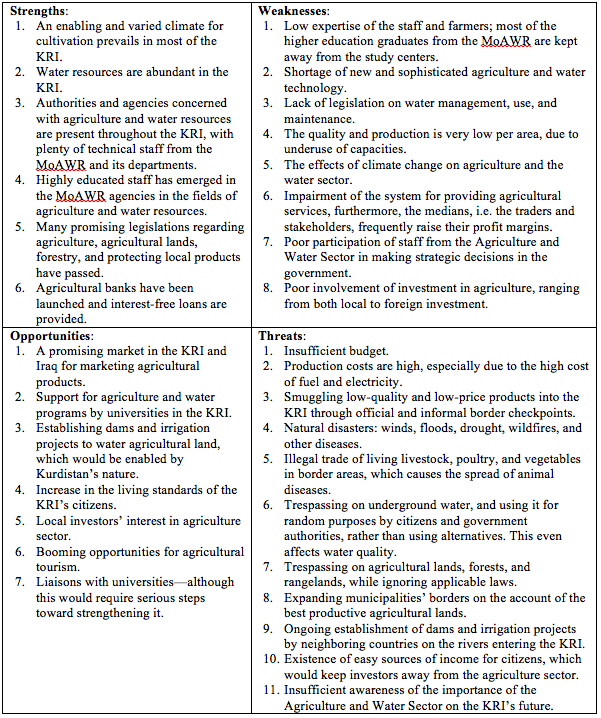
10- Obstacles and risks
It is clear that any plan, action, and program may face obstacles, resistance, and risks; this roadmap is no exception. The following issues should be addressed in order to apply the right solution at the right time:
11- Objectives and strategic goals
First objective: increasing and reforming agricultural products, vegetables, and meat animals
Goal No. 1: production of 1,220,000 tons wheat annually
Goal No. 2: Production of 345,000 tons barley and 33,950 tons corn for fodder
Goal No. 3: production of 17195 tons chickpeas, 6700 tons lentil and 5495 tons sunflower seeds annually
Goal No. 4: Production of 664,300 tons of vegetables annually
Goal No. 5: Production of 245,287 tons of fruits annually
Goal No. 6: Production of 140,000 tons of chicken meat annually
Goal No. 7: Production of 93,500 tons of red meat annually
Goal No. 8: Production of 4,204 ton fish meat annually
Goal No. 9: Production of 1750 Million eggs annually
Goal No. 10: production of 494,000 tons of milk annually
Goal No. 11: production of 1,094.5 tons of honey annually
Second Objective: Ensuring a water storage capacity of 10,500 billion m3 and irrigating 1,561,760 Donums of agricultural land.
Goal No. 1: Increasing storage capacity to 10.5 billion m3.
Goal No. 2: Irrigated cultivated land reaching 1,561,760 Donums.
Third Objective: Upgrading the scientific level and vocational skills of employees, strengthening study centers, conducting studies on the needs and requirements that will achieve sufficient quality and quantity, solving problems that face conducting studies, and ensuring the role of Agricultural Supervisors in raising farmers’ awareness.
The situation of agricultural researches and extension centers

Technical Staff of the MOAWRWR
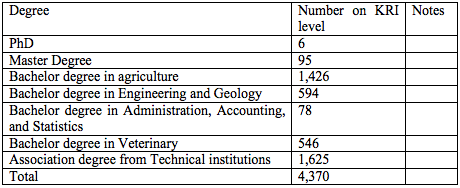
Goal No. 1: developing and achieving new types of products in regards to the productivity and resistance to diseases and drought
Goal No. 2: developing Natural Resources
Goal No. 3: increasing and improving animal and poultry products
Goal No. 4: special studies on agricultural diseases, pesticides, and weeds
Forth Objective: increasing and developing forestsand rangelands
Goal No. 1: Increasing the area of forests.
Goal No. 2: Natural forest development
Goal No. 3: Development of natural rangelands
Goal No. 4: increasing man-made rangeland spaces
Fifth Objective: Reforms in agricultural services and agricultural banking
Goal No. 1: providing sufficient services to the farmers via modern technology, accredited true seeds, and supporting marketing
Goal No. 2: Connecting weather forecast networks to production and predicting agricultural diseases. Processing data on weather, rain, winds, and temperature to obtain information and provide access to farmers with this information online.
Goal No. 3: Selecting the proper seeds and plants for the KRI’s soil and weather, including working on the production map and directing support toward investing the right products in the right soil.
Goal No. 4: Connecting support to productive farmers with productive economic criteria and providing encouragement and support to farmers in order to establish associations and cooperation among themselves as well as with small- and medium-sized farm owners, with the purpose of unifying all capacities.
Goal No. 5: Expanding agricultural banking services to include all production and marketing processes, raising the limit of loans to one billion dinars, continuing to keep banks open for farmers throughout the year, and easing the terms and conditions of lending to the farmers.
Sixth Objective: Protecting animals’ health in order to provide healthy food to citizens
Goal No. 1: controlling and preventing the spread of cross-border diseases and transmittable diseases
Goal No. 2: Protecting food safety and public health
Goal No. 3: Improving animal breeds
Goal No. 4: conducting needed tests on livestock, poultry, and fish for diseases, and infectious diseases
Goal No. 5: upgrading the performance of the Central Veterinary Diagnostic Lab in the KRI
Seventh Objective: Reforms in agricultural products’ marketing system
Goal No. 1: Provision of support for the establishment of marketing associations and companies
Goal No. 2: Proposing laws and instructions on marketing for regulating relations between farmers with traders, byers and consumers under the oversee of The MoAWR, and proposing a special law on encouraging export of agricultural products
Goal No. 3: Establishing marketing information system
Goal No. 4: paying attention to industrializing agricultural product
Goal No. 5: Supporting the establishment of associations for producers of red meat, chicken meat, fish and dairy products.
Eighth Objective: Sustainable management of agricultural land in order to provide an enabling environment for agricultural production, settlement of the farmers on their lands, and attracting capital for the farms.
Goal No. 1: Revision of governing laws
Goal No. 2: Providing a well trained staff for departments of real estate and properties
Goal No. 3: Acknowledging agricultural land as a national resource, and removing obstacles ahead of agricultural lands
Goal No. 4: proper lands allocation for investment in agriculture
12- The Projects needed to be complemented by investors

13- The policy for Agriculture and water sector in Kurdistan region
13-1 agriculture sector:
First: Support policy:-
1-Price support:-
2-Supporting providing for production needs:-
3-Support Marketing:-
The policy for 2015 marketing support to chicken meat will be adopted, when succeeds; this support will be adopted for other products.
4-Supporting protection products:
A- From 2009 to 2014 the policy of preventing import products at local maturity season was operated, in 2015 protection of the local products were implemented by putting taxes on the imported products during production season. Putting such tax on imports will create a balance between imported and local products as listed follow:-
B- Controlling import of live animals, animal’s production and medicines and vaccines in illegally way.
5- Concessional financing:-
A- Since 2009 until now giving interest free loans for farmers for supporting to build an agricultural project and the ministry will continue supporting the farmers through the Agricultural bank.
B- Increasing agriculture loan ratio and generalization this lending to all stages and production requirements.
C- Establish a special fund in ministry of agriculture and water resources to support farmers.
6- Indirect support:-
Supporting electricity and fuel prices for farmers for example supporting for electricity price by 60% of real price.
Second: production policy :-
Third; land use policy:-
Forth: Administration and legal policy:
13-2 Policies in the Water Sector
14-Mechanisms for achieving objectives and indicators
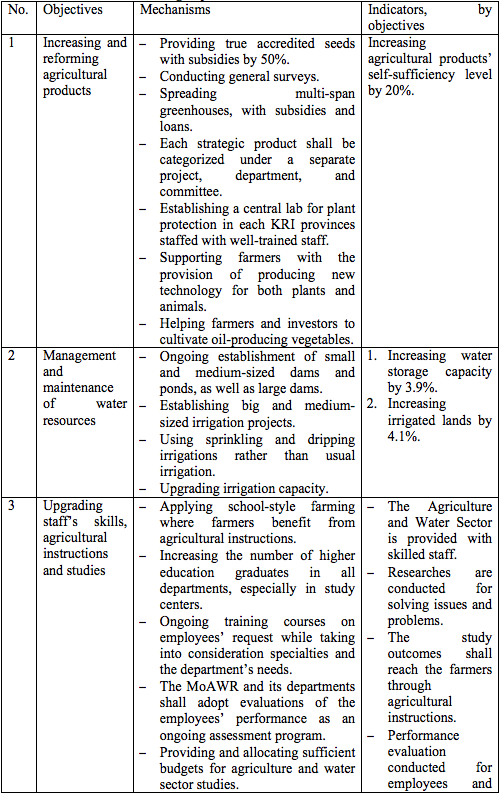

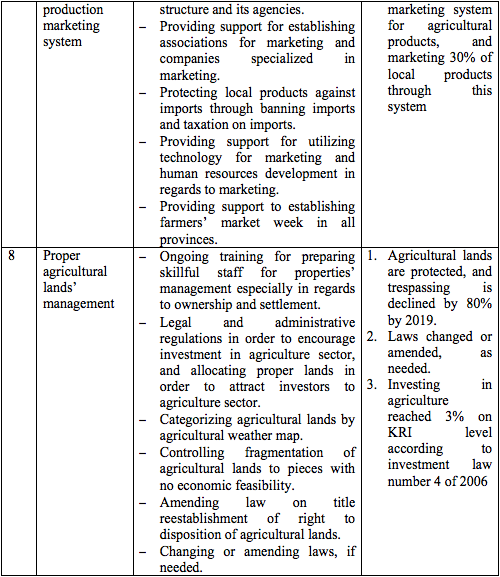
15- Evaluation
Each goal has indicators, and the evaluation is based on these indicators, as shown below: